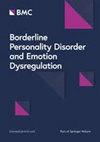Reduced positive attentional bias in patients with borderline personality disorder compared with non-patients: results from a free-viewing eye-tracking study
IF 2.7
2区 医学
Q1 PSYCHIATRY
Borderline Personality Disorder and Emotion Dysregulation
Pub Date : 2024-09-16
DOI:10.1186/s40479-024-00267-y
引用次数: 0
Abstract
Attentional processes are important for regulating emotional states and coping with stressful events. Orientation of attention acts as filter for subsequent information processing. So far, only few eye-tracking studies have examined attentional processes during emotion perception in borderline personality disorder (BPD). In these studies, gaze behaviour was analysed during simultaneous or delayed evaluation of single stimuli. The objective of the present eye-tracking study was to investigate early and late attention allocation towards emotional facial expressions in patients with BPD and non-patients (NPs) based on a free-viewing paradigm, which allows to examine processes of self-generated attention deployment. In a multiple-stimulus free-viewing task with facial expressions, i.e. happy, angry, sad, and neutral faces, presented simultaneously early and late attentional allocation was analysed in 43 patients with BPD and 43 age- and sex-matched NPs. We assessed study participants’ trait anxiety, depressive symptoms, level of alexithymia, traumatic childhood experiences, and borderline symptoms. Entry time was used to measure initial gaze orientation, whereas dwell time was calculated as an index of late attention allocation. As could be expected, patients with BPD reported more anxiety, depressive symptoms, experiences of childhood maltreatment, and showed higher levels of alexithymia than NPs. Patients differed from NPs in dwell time on happy facial expressions but not in dwell time on angry, sad, and neutral expressions. Contrary to our hypothesis, patients did not differ from NPs concerning entry times on angry facial expressions. According to our results, patients with BPD show a reduced attentional preference for happy facial expression during free viewing compared to NPs. A decreased positive attentional bias at a late processing stage could be part of emotion regulation impairments and add to the vulnerability for negative affects in BPD, which represent core symptoms of the disorder. In contrast to previous eye-tracking research in BPD examining attention during evaluative processing, our dwell time data could be more indicative of self-generated, endogenously controlled attentional processes in emotion perception. The present data do not support an early vigilance for threatening social information in BPD.与非患者相比,边缘型人格障碍患者的积极注意偏差减少:自由视线眼动跟踪研究的结果
注意过程对于调节情绪状态和应对压力事件非常重要。注意力的定向对后续的信息处理起着过滤作用。迄今为止,只有少数眼动追踪研究考察了边缘型人格障碍(BPD)患者在情绪感知过程中的注意过程。在这些研究中,分析的是同时或延迟评估单一刺激时的注视行为。本眼球跟踪研究的目的是基于自由观看范式,研究边缘型人格障碍患者和非患者(NPs)对情绪化面部表情的早期和晚期注意力分配情况。在一项多刺激自由观看任务中,43 名 BPD 患者和 43 名年龄和性别匹配的非患者的面部表情(即快乐、愤怒、悲伤和中性面孔)同时出现,我们分析了他们早期和晚期的注意力分配情况。我们评估了研究参与者的特质焦虑、抑郁症状、情感淡漠程度、童年创伤经历和边缘症状。进入时间用于测量最初的注视定向,而停留时间则被计算为后期注意力分配的指标。不出所料,BPD 患者比 NP 患者报告了更多的焦虑、抑郁症状和童年虐待经历,并表现出更高程度的自闭症。患者在快乐表情上的停留时间与非正常人不同,但在愤怒、悲伤和中性表情上的停留时间与非正常人不同。与我们的假设相反,患者在愤怒表情的进入时间上与 NPs 没有差异。根据我们的研究结果,在自由观看过程中,BPD 患者对快乐面部表情的注意偏好低于 NPs。在后期处理阶段,积极注意偏向的减少可能是情绪调节障碍的一部分,并增加了 BPD 患者对负面情绪的易感性,而这正是该障碍的核心症状。与之前对 BPD 患者在评价性处理过程中的注意力进行的眼动追踪研究相比,我们的停留时间数据可能更能说明情绪感知过程中自我产生、内生控制的注意力过程。目前的数据并不支持 BPD 早期对威胁性社会信息的警觉。
本文章由计算机程序翻译,如有差异,请以英文原文为准。
求助全文
约1分钟内获得全文
求助全文
来源期刊

Borderline Personality Disorder and Emotion Dysregulation
Psychology-Clinical Psychology
CiteScore
6.00
自引率
9.80%
发文量
30
审稿时长
28 weeks
期刊介绍:
Borderline Personality Disorder and Emotion Dysregulation provides a platform for researchers and clinicians interested in borderline personality disorder (BPD) as a currently highly challenging psychiatric disorder. Emotion dysregulation is at the core of BPD but also stands on its own as a major pathological component of the underlying neurobiology of various other psychiatric disorders. The journal focuses on the psychological, social and neurobiological aspects of emotion dysregulation as well as epidemiology, phenomenology, pathophysiology, treatment, neurobiology, genetics, and animal models of BPD.
 求助内容:
求助内容: 应助结果提醒方式:
应助结果提醒方式:


